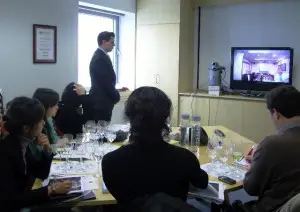 The authors of the article Asynchronous vs. Synchronous Interactions by T. Kung-Ming and S. Khoon-Seng did not consider television as a tool of asynchronous interaction. The article is based on the premise that those who are interested in distance education have access to computers and the internet. But, this is not always the case here in Thailand.
The authors of the article Asynchronous vs. Synchronous Interactions by T. Kung-Ming and S. Khoon-Seng did not consider television as a tool of asynchronous interaction. The article is based on the premise that those who are interested in distance education have access to computers and the internet. But, this is not always the case here in Thailand.
The King of Thailand started a royal-founded distance education project that used television as a tool of delivering the lesson. For this purpose, a special TV channel was set up. Classes filmed in regular schools were broadcast on this channel, with the teacher delivering the lesson, students asking questions and doing exercises together. Many students from remote areas in northern Thailand (usually from hill tribe families with low income who could not afford sending their children to school) benefited from this free educational channel. Students were not only offered Thai and Mathematics lessons, but also foreign language classes (French, English, Chinese, and Japanese). Special testing centers were then set up for students that followed the television delivered lesson and thus eventually given a certification recognized by the Thai Ministry of Education.
This tool of asynchronous interaction may not be very popular in other countries, but in Thailand it is the only way for children from remote areas to continue their education. Basically, the royal Thai distance learning project is a variation on lectures delivered via audiotapes and videotapes.
Similarities between asynchronous and synchronous interaction
Both kinds of interactions are:
– user friendly (requiring only basic ICT skills);
– cost and time effective.
Maybe that is why online learning is becoming increasingly popular.
My experience with synchronous interaction technologies
– Yahoo messaging allows one-to-one and group conferences. As suggested in the article, the more people take part in the conference, the more difficult is to keep track of who said what, and who replied to what comment. A closer to reality conference can be achieved through Yahoo voice conference, which is like being on the phone with more than one person at a time. (Skype offers similar facilities, maybe with better quality.)
– An application sharing software that has become increasingly popular in the last few years is the “wiki platform.” Nowadays, Wikipedia – the online encyclopedia is updated by individuals around the world. I also tried my hand at writing a few articles, editing other people’s articles and uploading pictures that I possessed copyright for. (There have also been some collaborative novel writing projects that used the wiki platform.
Problems with asynchronous interaction
Although such kind of interaction can be between learners of different nationalities from many parts of the world, they all need to have one thing in common: the language they use to communicate. This means that some learners may not be native-speakers of the language of instruction, and thus their language skills “affect communication effectiveness” (source, p. 109).
Problems with synchronous interaction
Learner-content synchronous interaction raises the following problem: How much content materials can be processed so that the activity remains time effective? My answer is: Not too much.
Why? Because maybe, for some learners, the material is new, so in order to provide a meaningful comment within the time constraints, the leaner-content interaction has to be smooth, without any frustrating elements (such as difficult concepts or highly-specialized terminology). That is why only lower thinking skills can be observed in synchronous interaction.
Example of synchronous interaction
On February 27, 2008, the Database section of The Bangkok Post (Boonruang, Sasiwimon. “Bridging cultures”) presented the first part of the Inter-Cultural Communication for Classrooms project which is run by the Thai Computational Linguistics Laboratory. In this project, students in two classrooms (one from Thailand and one from Japan) talked to each other, in real time, through the use of internet and a software that translated what the students said.
During the videoconference, only lower thinking skills occurred, the students being unable to engage in activities that stimulated higher thinking skills (due to time and technological restraints). It is a perfect example of synchronous videoconferencing, but the future success of the program depends on the technological part of the equation.
Image source
